5 thought experiments 2026
5 Five thought experiments to fix your returns before next peak Jennie Gerum December 2, 2025 6 min
If you think great products and solid customer service are enough to keep customers loyal, think again.
The returns process—how easy or frustrating it is—can make all the difference.
Imagine a customer returning a high-value order but left wondering if they’ll ever see their money again because your returns system is slow or unclear. That’s a fast track to lost trust.
A clunky, outdated returns process isn’t just an operational hassle—it’s a direct threat to customer retention. The uncertainty of where their return is, how long it’ll take, or whether it’s even been received can push your customers to look elsewhere. And when returns aren’t easy, they won’t come back.
In this post, we’ll highlight five warning signs that your returns process might be pushing customers away—and, more importantly, what you can do to fix it.
Ready to see if your returns process is up to scratch?
Customers expect simplicity and control. If your returns are still stuck in the manual age—think paper labels and no tracking—you’re probably driving your customers crazy. Imagine dropping off a return and having no idea when (or if) your money will be refunded. That’s the reality for customers dealing with outdated returns systems.
When customers can’t easily track their returns, they feel out of control and start questioning whether they’ll ever see their money again. Worse, this anxiety leads to a flood of inquiries for your customer service team. Stress for them, frustration for the customer, and a negative brand experience all around.
Why it matters:
Research shows that 92% of customers are more likely to return to a brand if the returns process is easy. If you can offer a digital, transparent system that takes the uncertainty away, you’re already increasing the chances they’ll shop with you again.
What to do about it:
Give your customers peace of mind by offering a fully digital returns process. With real-time tracking and clear communication, they’ll know exactly when their refund is coming, reducing stress and making them more likely to shop with you again. Plus, less pressure on your customer service team means happier staff.
Why ship every return to a central warehouse when you don’t have to? Let’s say a customer returns a pair of jeans with a broken zipper. Does that really need to go to the main warehouse first, only to be sent out again for repairs?
Sending returns on a detour is a waste of time and money—both for you and your customers. A smarter way? Send items directly where they need to go, whether that’s a repair hub, recycling center, or another specific location. This way, the jeans are repaired faster, costs are lower, and the customer gets their item back quicker.
What to do about it:
Implement intelligent product routing. Make sure returns go straight to the right destination—whether it’s repairs, refurbishment, or resale—without unnecessary stops. Less handling means lower costs, quicker resolutions, and happier customers.

Selling globally is great, but if you’re making all international returns go back to a central warehouse—especially across borders—you’re setting yourself (and your customers) up for frustration. Think about it: A customer in the U.S. returns a product, and it has to go all the way back to Europe before it’s processed. The costs add up, and the wait times are painful.
Real-life example:
Take Nudie Jeans, for example. They’ve handled over 4,500 pairs of jeans in Australia alone, avoiding the cost and environmental impact of shipping each pair back to their central warehouse in Europe. Instead, they’ve set up local repair hubs, saving on shipping costs, speeding up the process, and offering a better customer experience.
What to do about it:
Consider setting up regional return hubs or working with partners that can handle local returns. You’ll cut down on costs and give your customers a much faster, smoother experience. Or, bundle return shipments in bulk to save on customs fees and shipping costs, while still providing a local presence.

Are you still paying full freight costs for returns when customers only send back part of their order? That’s an unnecessary expense. If a customer returns two out of five items, you shouldn’t be paying the same freight as if they returned the whole order.
What to do about it:
Automate your freight sizing based on the volume of the returned items. This way, when a customer returns half the order, you’re only paying half the freight costs. It’s an easy win for reducing expenses without compromising customer satisfaction.
Ever tried handling a claim when the customer doesn’t have an order number or is outside the warranty period? It’s a nightmare—both for you and the customer. But if you make the process too rigid, you’re risking customer satisfaction. Make it too loose, and your ERP system could be a mess.
Why it matters:
A smooth returns process isn’t just about logistics—it’s about building long-term trust. When you make it easy for customers to file claims, they’re more likely to stay loyal. A bad returns experience? It’ll send them straight to a competitor.
What to do about it:
You need a system that can handle these edge cases without breaking the rules. Automate the process so that even without an order number or when outside the warranty period, you can still create an order in the system, process the claim, and keep things compliant. Better yet, offer fast refunds when possible. Your team stays efficient, your customers stay happy, and your books stay clean.
Your returns process isn’t just about logistics—it’s a critical part of keeping your customers loyal. Fixing these five issues will improve your customer experience and help you boost retention, reduce churn, and increase long-term customer value.
Want to know how Nordic Nest reduced their lead times and cut 7,000 hours of manual labor annually? Read the case here!
5 Five thought experiments to fix your returns before next peak Jennie Gerum December 2, 2025 6 min

Why the fashion industry is solving the wrong problem New research reveals that the solution to rising return costs isn’t better fit - it’s better control. Fashion brands have spent years ...

The real profitability killer in e-commerce The real growth metric in 2025 isn’t sales, it’s profit after returns.And the real profitability killer in e-commerce? It’s not returns thems...